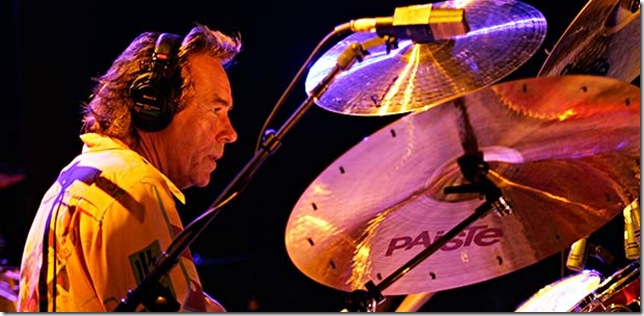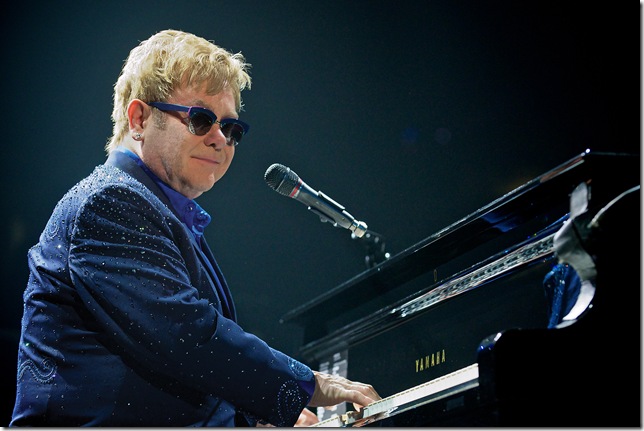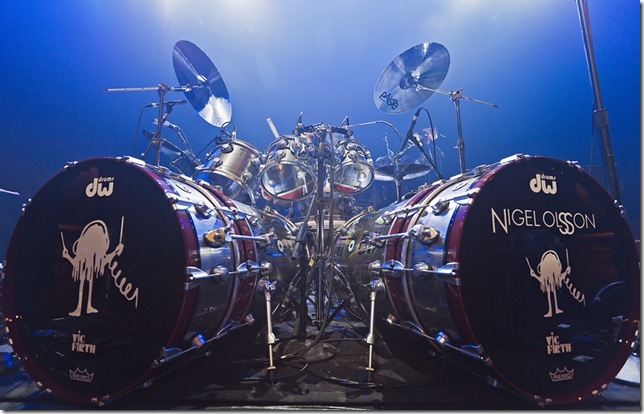Even if you know drummer Nigel Olsson’s name, you may not know he’s worked with the Spencer Davis Group, Uriah Heep, Jimmy Webb, Neil Sedaka, Linda Ronstadt, Rod Stewart, Rick Springfield, Leon Russell, Helen Reddy, Bob Weir, Barry Manilow, Kenny Rogers, Toto, and B.B. King.
But you’d likely know the singular Olsson association that overshadows those. The 66-year-old has been both the primary drummer and a vital backing vocalist for Reginald Dwight, a.k.a. Sir Elton John, for most of the past 45 years. He’s played more than 2,000 of the 67-year-old John’s nearly 3,000 career live shows, and will add to his total when the band performs at American Airlines Arena in Miami on March 6.
Olsson recorded early demos with John, then appeared on intermittent tracks from his 1969-1971 studio albums Empty Sky, Tumbleweed Connection and Madman Across the Water before becoming a full-time recording and touring member in 1972. After that, he played and sang on the successive No. 1 releases Honky Chateau, Don’t Shoot Me … I’m Only the Piano Player, Goodbye Yellow Brick Road, Caribou and Captain Fantastic and the Brown Dirt Cowboy —and thus on the chart-topping hits “Honky Cat,” “Rocket Man,” “Daniel,” “Crocodile Rock,” “Candle in the Wind,” “Bennie and the Jets,” “Saturday Night’s Alright for Fighting,” “The Bitch Is Back,” “Don’t Let the Sun Go Down on Me” and “Someone Saved My Life Tonight.”
For most musicians, that would make for a phenomenal career. For Olsson, it all happened from 1972 to 1975, shortly after he’d permanently moved from England to the United States to unwittingly help John become the biggest pop star in the world. Concert listeners are likely to hear all of those songs — plus some from John’s latest CD, 2013’s The Diving Board — during stops on the lengthy, international All the Hits tour that starts on Friday in Cincinnati.
“It’s been a long journey, with some wild times,” Olsson says from his home in the Los Angeles suburb of Woodland Hills, where he lives with his wife Schanda. “But at the time we were getting so popular, we were too busy to realize it. We were constantly touring, then back into the studio to record another album to have it in the can before hitting the road again. So it never really registered. We eventually found out we’d become huge in the U.S., even though we’d gotten nowhere in England at the time. But that’s changed, and I’m absolutely still having a blast.”
The drummer’s excitement over his forthcoming itinerary was palpable even by phone in late January, and with additional reason.
“We go into the Village Recorder Studios in Hollywood tomorrow to record Elton’s next album,” Olsson says. “Hopefully it’ll be the way we used to record, where everybody helps craft the songs in the studio and then we go and cut our parts, because we’ll all be there for three weeks. It’s my first recording with him in awhile, and the tour starts shortly after that.”
It may come as a surprise that Olsson met John when both were struggling session musicians (yes, Elton once had to look for work, whereas now it seems to look for him). The drummer was previously a lead singer for the Sunderland, England-based group the Fireflies, and added drums to his résumé when that band’s drummer quit. John was quietly working with writing partner Bernie Taupin, who would eventually compose lyrics for the bulk of his catalog.
“I met Elton around 1967,” Olsson says. “That was in London, where he was writing with Bernie for the Dick James Studios organization. They were also a publishing company for The Beatles, the Spencer Davis Group, The Troggs and many others. He and Bernie were recording demos, and I was also there, so they’d ask me to play on some tracks. And it all grew out of that.
“It’s amazing, because Elton initially just wanted to be a songwriter, not a performer. But Dick James wanted him to play live in England to get his songs out there, so he asked myself and Dee Murray if we’d play out with him. We started rehearsing at the studio, and the first thing we played was Elton’s future hit ‘Your Song.’ And within about the first eight bars it clicked. I knew this was the music I wanted to play; something new, original and fresh.”
Bassist Murray and Olsson, who’d formed a simpatico and sweet-singing rhythm section in 1969 with a post-Steve Winwood lineup of the Spencer Davis Group, also joined John for his first tour of the U.S. in 1970. Ironically, they were supporting John’s self-titled 1970 LP (with “Your Song”) even though neither recorded on the album. But the opening week-long residency at famed Los Angeles nightclub The Troubadour made John a rising star, and the trio came back from England later in the year for a second U.S. run.
For unofficial evidence why Olsson and Murray were eventually hired by John full-time, check out 11-17-70, the impromptu 1971 live CD named for the date of its recording and captured during that second U.S. tour. Engineered by Phil Ramone, the occasion was a rare live radio broadcast on WABC-FM in New York, captured at A&R Recording Studio in the Big Apple before an invited audience of about 100 people.
If one thinks of a piano trio only as a jazz act, and a power trio only in terms of guitar-based rockers like Cream and the Jimi Hendrix Experience, they haven’t heard 11-17-70. The disc displays a young, hungry John — before the lavish costumes and glasses that would help to define him during that meteoric rise to fame over the next few years — in peak singing and playing form. There are fiery renditions of early gems like “Take Me To the Pilot,”
“Can I Put You On” and “Burn Down the Mission,” plus creative covers of The Beatles’ “Get Back” and the Rolling Stones’ “Honky Tonk Women,” all with equally powerful accompaniment and choir-like vocal harmonies by both Murray and Olsson, then still hired touring guns. The result is perhaps the hidden gem among John’s lengthy career catalog.
“When people listen to it,” Olsson says, “they still say, ‘Wow, that was live?’ Dee and I loved putting together backing vocal parts, and Elton and producer Gus Dudgeon [1942-2002] always let us come up with our own. And it was a great-sounding studio to record live in.”
In the CD’s liner notes, John recalls his surprise at discovering the quality of the live recording, and points out the performances of his rhythm section, all factors in the live disc’s eventual release.
“We didn’t know at the time,” he writes, “but afterwards we found out that [production coordinator] Steve Brown had arranged for an eight-track recording to be made — just to see how it came out — and when we listened to it, we thought it was quite good. I also wanted it to come out because Dee and Nigel, who had been on very little before, were featured very strongly.”
John, Murray and Olsson would be joined by gifted guitarist/vocalist Davey Johnstone, who’d also made occasional appearances on John’s previous studio albums, to round out the pianist’s classic quartet lineup on Honky Chateau, Don’t Shoot Me and the epic 1973 double-LP Goodbye Yellow Brick Road. Percussionist Ray Cooper, a session player on that release, made it a quintet by its 1974 follow-up, Caribou. Most of that lineup will appear on the All the Hits tour, which will emphasize Goodbye Yellow Brick Road, an expanded version of which was released in 2013 to celebrate its 40th anniversary.
The sad exception is Murray (1946-1992), who battled skin cancer for years before dying at age 45 after suffering a stroke. A vastly underrated pop bassist in the post-Paul McCartney era (with additional credits including Bob Weir, John Prine, Procol Harum, and Alice Cooper), Murray’s loss resonated through that entire lineup, and especially his old friend Olsson.
“I miss him every day,” he says.
The lineup for the bulk of the current tour, and that forthcoming untitled CD, is John, Olsson, Johnstone, bassist Matt Bissonette, percussionist John Mahon, and additional keyboardist Kim Bullard. Percussionist Cooper’s appearances will be live in Las Vegas, where John and company spend a month between March 18 and April 14 at The Colosseum at Caesars Palace. Yes, if John’s often garish outfits seemed destined for Vegas from the 1970s on, then life has indeed imitated art.
“The Vegas show is different from the standard road show,” Olsson says. “Ray plays with us on a few songs, and it’s great to work with him. His time is unbelievable. When we play together, I always feel this metronome quality in him.”
Yet even though John plays Vegas annually, it isn’t a pre-retirement show that only rides the coattails of his 1970s glory days. His re-make “Candle in the Wind ’97” became the top-selling single of all time at 37 million copies 18 years ago; his single “Home Again” from The Diving Board was recently his 69th entry on Billboard’s Adult Contemporary chart, also a record. He has 35 gold and 25 platinum albums among his 250 million record sales worldwide. John’s soundtrack work for popular animated films like The Lion King (1994) and The Road to El Dorado (2000) has added to those totals, and to his audience.
“We’ll still play places like town squares in Italy that draw 200,000 people,” Olsson says. “And at every one of our shows, I see grandparents who were listening in the ’70s and children who were drawn in by the animated soundtrack material.”
With his signature setup of over-sized Drum Workshop drums (including two extended kick drums) and Paiste cymbals, Olsson achieves a huge, classic sound similar to Phil Collins’ with Genesis, yet he plays with the sparseness of The Beatles’ Ringo Starr or the Stones’ Charlie Watts. The singing drummer has also released a handful of solo albums since 1971, most during that decade, when he actually appeared on Dick Clark’s popular American Bandstand TV program as a solo artist.
“My drumming sound is a combination of large drums and both close and ambient microphone techniques,” Olsson says. “And my playing is fueled by the low end of Elton’s piano and the lyrics. I think I tend to hold song tempos back just a little bit, to the point where it’s almost as if I’m playing a little behind the beat, especially on ballads. It can make songs like that seem more intense, and from the heart.”
That style is likely to be on display on numerous tracks from Goodbye Yellow Brick Road, perhaps the preeminent pop release of the 1970s. Aside from the hits, leading album track contenders include the lengthy opening suite “Funeral for a Friend (Love Lies Bleeding),” the title ballad, and perhaps the rocker “All the Girls Love Alice” — which also featured sounds from the engine from one of avid car buff Olsson’s several automobiles.
“That’s my 1971 Mini Cooper,” he says. “Dudgeon had me drive it while my brother Carl hung out the back window with a microphone near the exhaust pipe.”
A father and grandfather, Olsson rejoined John as a touring drummer from 1980 (beginning when he and Murray played Elton’s Central Park concert in New York City for an audience of 500,000) to 1984, and again from 2000 (starting with another watershed New York gig at Madison Square Garden on the One Night Only tour) to present-day.
“When Elton was recording ‘The Road to El Dorado’ soundtrack 15 years ago,” Olsson says, “Davey actually was the one who called to ask if I’d be willing to record just background vocals. He wondered if I’d be offended that I wasn’t also playing, but I was happy to just sing on it. Elton asked me later if I’d also consider coming back as a full-time drummer. And I said, ‘Well, let me think about it … yes!’”
Still sporting the accent of an English country gentleman even though he’s resided in various parts of the U.S. since 1971, Olsson embodies the role. Even though he’s been let go several times by John and doesn’t appear on his every release, including The Diving Board, Olsson has nothing but praise for his friend and on-again/off-again employer.
“He really is one of the most kind and decent people I’ve ever met,” he says, “and just a fantastic singer and musician. He’s raised multi-millions of dollars for his AIDS foundation, and awareness through its educational programs. He has a huge heart. It’s been an honor to be part of Elton’s history, practically from day one, and quite a few years since I did a full-blown album and tour like this with him. So this is a really exciting time.”
See Elton John’s All the Hits concert March 6 at American Airlines Arena, 601 Biscayne Blvd., Miami (786-777-1000 or 800-745-3000, $36-181.25).



